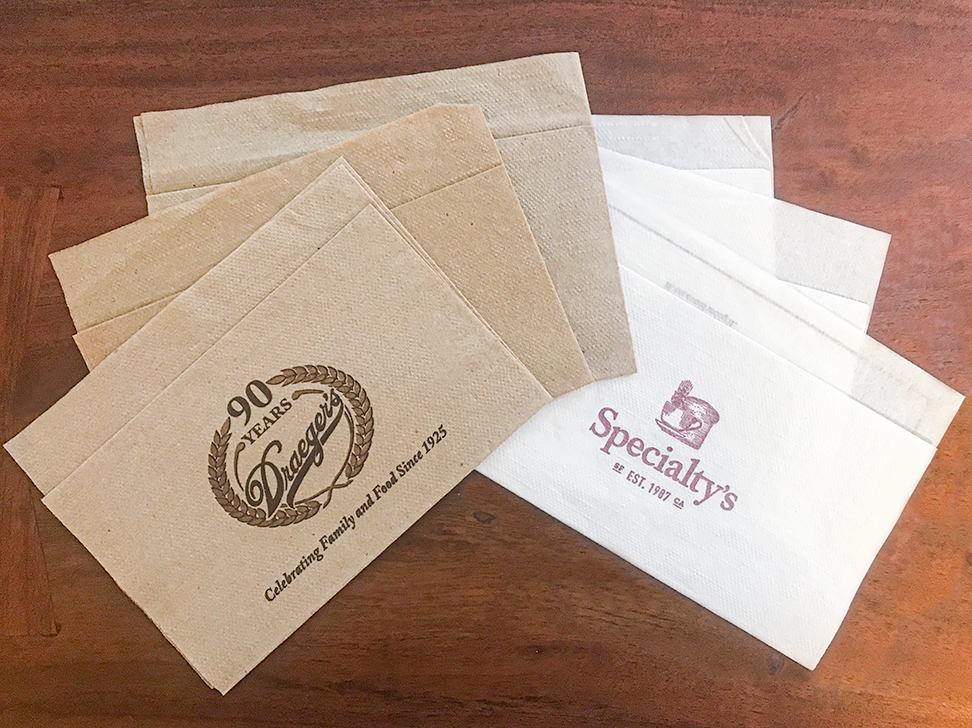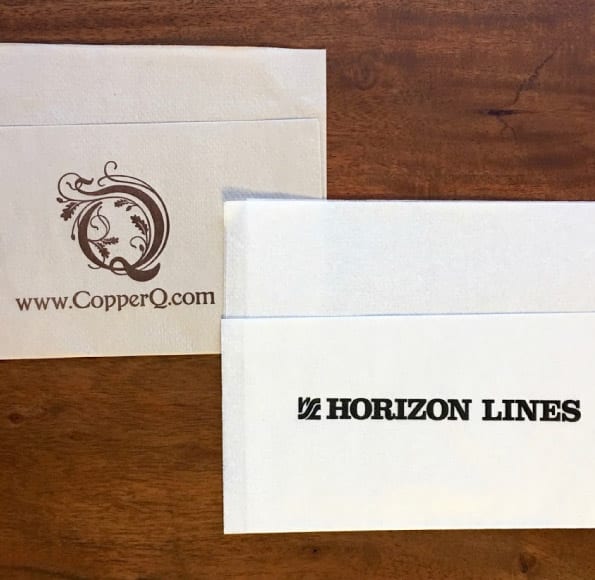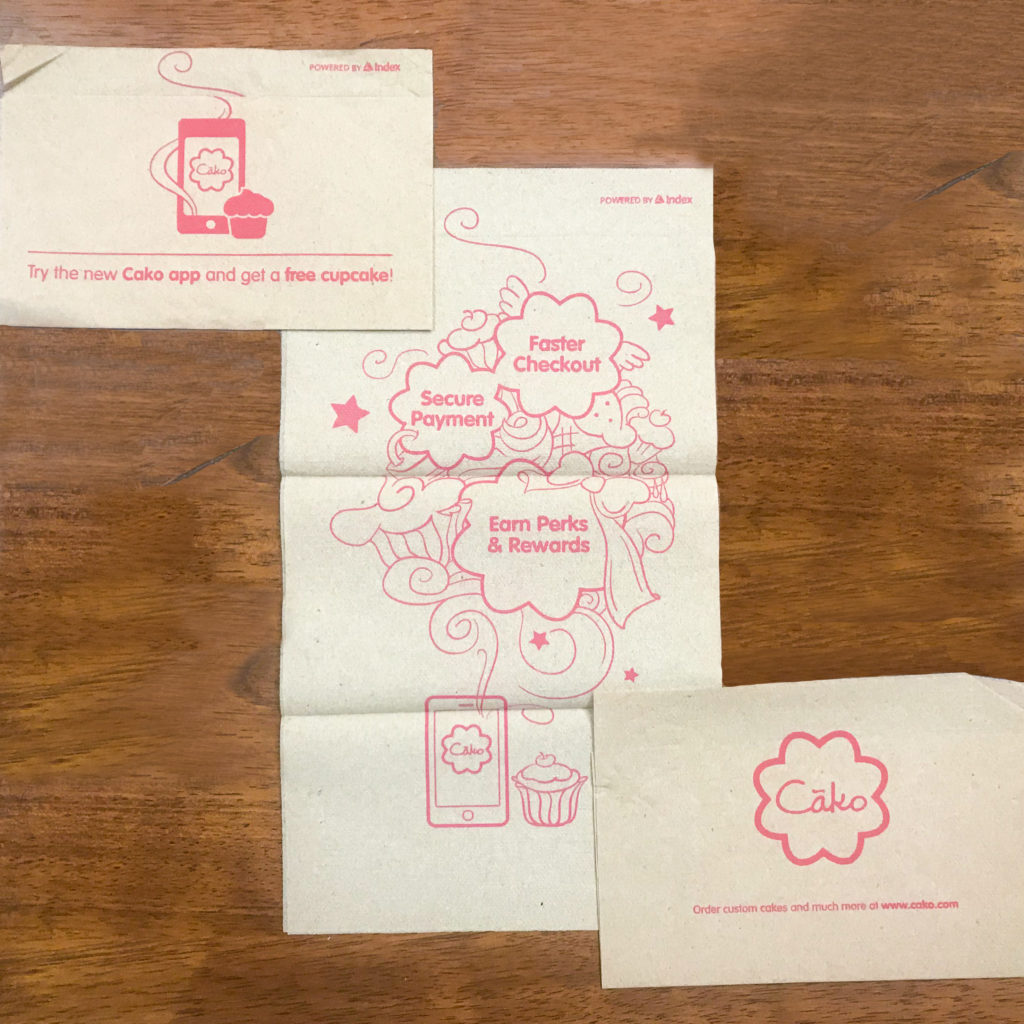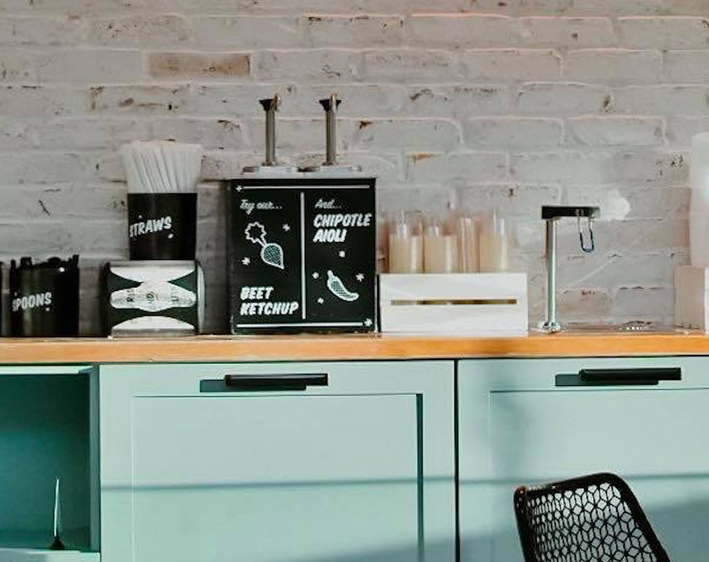Restaurant napkin dispensers are ubiquitous. And as a new restauranteur, bar owner, or event planner, you may not have given them much thought.
But, as with any new business, the devil is in the details.
Restaurant napkin dispensers carry a surprising amount of power. They add supply cost, increase customer satisfaction ( or frustration), and provide marketing possibility… simultaneously.
So, let’s dive into the wonderful world of restaurant napkin dispensers. We’ll help you optimize your napkin use along the way.
The Basics
We’ll start with the part you already know.
What is a Napkin Dispenser?

A napkin dispenser can be any device used to store and disperse napkins to your customers. Most dispensers consist of a small spring-loaded metal box, sitting atop your tables or at your condiments bar. Less commonly, a napkin dispenser can be a basket, a metal slot, a roll of paper towels, or even your employees behind the counter.
The Dispenser Napkin

Dispenser napkins are a specific subset of paper napkin. They are cut and folded to the industry-standard size of 6.5″ x 8″. Typically, they are made with kraft (brown) paper and have an all-over pebble emboss. And, dispenser napkins are environmentally friendly; they contain the highest levels of recycled material for all paper napkin types.
The general public associates dispenser napkins with cafes, coffeehouses, and other quick service restaurants. Like other paper napkins, dispenser napkins are available blank, or with customization.
Where to Put Your Napkin Dispensers

So you got the dispensers. Now you need to decide where and how your customers will get their napkins. Will you provide a set amount with every purchase? Or will you provide them freely at the table or at an amenities counter?
There are proven advantages to both, but I will argue the merits of freely providing your napkins.
Cost Savings Behind the Counter?

A few well-known food chains keep disposable napkins behind the counter. Most of these are large, multinational conglomerates who operate on extremely thin margins (pennies per customer).
With razor thing margins, it makes financial sense to limit napkins. But, one can get custom printed napkins for $0.01/napkin and blank napkins for even less than that. For each unused napkin, a company saves only a penny or two per customer. Unless you’re dealing with millions of customers, the cost savings are pretty negligible.
What are the Benefits of Napkins at Will?
Customer’s don’t want to wait, and they don’t want to be left wanting. Need napkins and can’t get more? Customers report decreased overall satisfaction, regardless of food quality. In fact, a study from Pacific Research Group found that napkins alone account for 10-20% of overall customer satisfaction at a restaurant.
Napkins are an expected freebie. And limiting napkins, or keeping them behind the counter, is a minor annoyance.
A single minor annoyance may be ignorable, but combine it with other minor annoyances that day (Out of your customer’s favorite item? Cranky associate? Long line for the bathroom?) and it hurts your brand. Too many annoyances, and you risk turning customers away.
Ideally, you want your customers to experience as few pain points as possible. While it’s unrealistic to assume you will satisfy every customer desire, at every moment, on every visit, you have direct control over your customers’ access to napkins. From a customer service perspective, it is safer to provide too many, than too few.
But What About Customers Who Waste Them?
It’s true that some customers will take too many, not use them, and throw them away. And some customers will take too many, stash them in their pocket or purse, and hoard them in their glovebox or junk drawer.
But let’s explore both points further.
Left Behind
Napkins left on the table are indeed wasted. And while no one can prevent the problem entirely, a few simple optimization tips can decrease supply costs.
- Type of Dispenser: The type of napkin dispenser you use affects how many napkins your customers take. Certain dispensers dispense napkins one at a time (similar to a tissue box). Such dispensers inhibit the “napkin handful grab” most likely to result in waste. Over time, single-napkin dispensers reduce use by up to 25%.
- Location of Dispenser: Adjusting where you keep your dispensers also affects usage rates. Do your customers grab too many from the condiment bar? Try tabletop dispensers. Do you see napkins left behind on the table? Try in-counter or wall dispensers farther away. The perfect set up will vary between businesses, but if waste is a concern, changing up dispenser location can modify usage rates.
Both adjustments will affect how customers interact with your napkins. But neither hinder customer experience.
Taken With

Napkins left on the table may be trash, but napkins that a customer hoards provide opportunity.
Stashed napkins have marketing potential. If your customer takes home a pile of custom printed napkins, your brand has followed them. Any time your customer picks up your napkin, whether from the car glovebox or the junk drawer at home, they see you. And over time, your brand strengthens. Customers cannot forget about your business if your name follows them home and ends up, quite literally, in their face.
You can see an interesting example of this phenomena by searching “napkins” on Twitter. Patrons recognize brands who provide copious napkins in easy-to-grab stacks. As such, you get a near-endless stream of tweets from QSR’s targeted demographics saying, “Well, looks like I’m running low on napkins. Time to go back to [brand name]!” Such tweets directly contrast other well-known brands, whose similar napkin-related tweets involve complaints about “stinginess” or “low-quality.”
Even better, these brands acknowledge and encourage it. Management understands that napkins drive sales.
And that napkins make customers happy.
Finding Your Perfect Restaurant Napkin Dispensers
Of course, few restaurants operate with the same budget as these large QSR establishments. But every restaurant needs napkins. And for most quick service establishments, whether a big multinational chain or a local mom and pop shop, those napkins will likely come out of a dispenser.
So what’s the budding restauranteur to do?
For most restaurants, the answer probably lies between both extremes. And while finding that balance can be tricky, it is doable with a bit of sleuthing.
Observing Your Customers

If resources permit, take a popular mealtime and observe your customers carefully. How do they interact with your napkins? Do they stock up before the meal, leaving the waste behind? Do they selectively take napkins as needed throughout the meal? Or, do they gather napkins at the end to take with them?
Now compare how many your customers take to how many are used throughout the meal. Is that number higher or lower than you expected?
It is imperative that you gather behavioral data directly from your customers. The more you can ignore your biases and rationally observe customer behavior, the better you serve your unique customer base.
Every company, restaurant or otherwise, carries biases about customer behavior. By honing your observational skills, you avoid acting from assumption. And ultimately, you gain the necessary data to optimize your dispensers.
Optimizing Your Restaurant Napkin Dispensers

From there, tweak your set-up as needed. Move dispensers around. Try a new dispenser type. Try new napkins. Record napkin use. See if customers return more or less. Check review sites for an uptick in positive or negative reviews. And keep watching.
The best dispenser napkin set-up will vary between businesses serving different cuisines (coffee bar vs barbecue joint) and/or serving different customer demographics (single earners vs married w/ kids). Ultimately, the perfect set-up is unique to your business.
In Summary
Choosing your dispenser set-up can be a daunting, confusing task, but with a bit of careful sleuthing, you can optimize your utility (and marketing!) costs.
Your customers probably use your napkin dispensers more or less often than you expect. By carefully observing behavior and adjusting accordingly, you can significantly reduce napkin waste without sacrificing customer satisfaction.
And by branding your napkins, you create small mobile advertisements for customers who take your napkins home.
Ultimately, each interaction your customer has with your business, employees, product, or supplies represents opportunity. And your napkin dispensers are no exception. Done right, your customer should have a seamless experience. Done even better, your dispenser napkins should drive more sales.
What could be better than that?
Leave a Reply